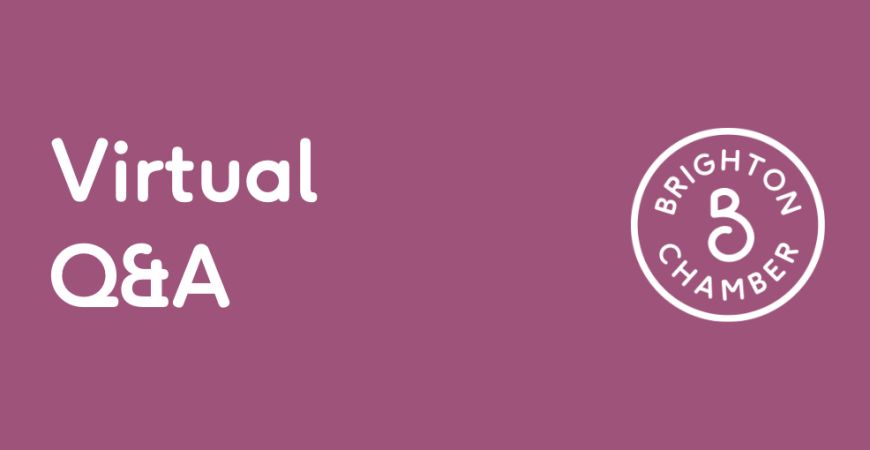
Tue 14 / 04 / 20
Q&A Blog: Government business support and what it means for your business
By Lauren Psyk
You will no doubt have seen the financial support packages announced by the chancellor to help businesses affected by coronavirus. But unless you’re a financial whizz, it’s hard to wade through the detail and see exactly what you’re entitled to and how it all works.
Luckily, we’ve had an expert on hand to help Brighton Chamber members to understand what’s available. Peter Hedgethorne, Director at Plus Accounting, has been answering all your burning questions via Zoom. We’ve summarised the key points here, but if there’s something you need to know that isn’t covered, do get in touch and we’ll do our best to find the answer or point you in the right direction.
Job Retention Scheme and the rules of furlough
- The Job Retention Scheme enables employees to ‘furlough’ staff; this is a legal term which means staff are kept on the payroll whilst not working.
- Once employers have established which staff are not required during this period, they should write to staff with a formal agreement asking them to agree to be furloughed.
- The case for furlough needs to be as strong as possible. Employers need to be able to demonstrate that they have assessed the need for staff during this period and that they would otherwise have had a decent case for laying these people off.
- It is important not to allow furloughed staff to do any work for you during this period. However, they are allowed to do training and voluntary work for other organisations (such as the NHS).
- The scheme only applies to employees who were on the payroll on 28th Feb 2020.
- For employees on a salary, their employer can claim back 80% of their salary as at 28th Feb 2020.
- Furlough documents (formal agreement. and employees’ acceptance if separate) need to be kept for 5 years.
- The HMRC Job Retention Scheme portal is due to be online on 20 April.
- The details required have been changed (not yet in guidance). The employees’ NI numbers and their individual grant figures, broken down into salary, employers’ NIC and minimum employers’ pension contributions will be required.
- For staff on variable pay and/or zero hours contracts, employers can look at their average earnings over the 2019/20 tax year and claim back 80% of that.
- The scheme allows you to claim a maximum of £2,500 per month per employee.
- Employers can also claim back NIC contributions.
- Benefits such as company cars, gym memberships etc cannot be claimed for.
- The minimum wage increase in April does not apply; employers can only claim 80% of salaries as they were on 28th Feb 2020.
- To access this support, there will be an internet portal via HMRC going live at the end of April where employers can make claims.
- The information needed to make a claim will be: PAYE reference, number of employees you are claiming for, the period you are claiming for (the minimum time you can furlough someone for is 3 weeks), the amount you are claiming, your bank details and your contact details.
- HMRC reserves the right to audit your calculations so make sure you keep a detailed record of how you arrived at your figues so it’s clear you haven’t claimed more than you are entitled to.
- If you have been placed on the high-risk register and are self isolating for 12 weeks, you can be furloughed and put on the Job Retention Scheme. You are also entitled to statutory sick pay from day one (£95.85 per week).
- It is acceptable to get another job whilst you are on furlough and still get your money from furlough.
- During furlough, staff are still entitled to annual leave and they are still accruing it. Annual leave that had already been booked can be furloughed. You can carry forward any unused holiday for the next two holiday years. Staff can be encouraged to take leave during their furlough period, however, employers do not have to include annual leave in their furlough claim if they do not want to.
- Doubt has been expressed over how annual leave has to be paid – some people are saying that it has to be paid to furloughed employees at the full rate.
For more detailed information on the Job Retention Scheme, head here.
Self-employment scheme, and the notable exclusions to the scheme
- The Self-employment Income Support Scheme is similar to the Job Retention Scheme, and it applies to self employed people with profits up to £50,000 and whose self employed income amounts to over 50% of their total income.
- Those who are eligible will receive a grant equivalent to 80% of their average monthly earnings over the three previous tax years (16/17, 17/18 and 18/19). The grant will extend for three months to the end of May.
- To qualify, your business needs to have been adversely affected by the coronavirus, you need to have been trading in tax year 19/20 and planning to continue trading in tax year 20/21.
- You do not need to apply; HMRC will write to all those who are eligible but money will not be available until the end of June.
- Exclusions: Company directors are excluded but they will be able to put themselves on furlough. While on furlough, company directors are only allowed to carry out statutory duties required to keep the business going. They are not permitted to continue providing services, carrying out marketing activities or pitching for new business.
- Dividends will not be counted in the amount you can claim on furlough; only your salary.
- Other support for company directors includes loans, universal credit or child benefit (if your earnings fall below the threshold).
- If a company has two directors, only one of them can be put on furlough; the other one has to be continuing with statutory duties required to keep the business going.
For more detail on the Self-employment Income Support Scheme, head here.
Business Interruption Loans
- The advantage of these loans is that you do not need to pay interest for 12 months and there is also a capital repayment holiday of 12 months.
- However, normal lending criteria applies and a strong business plan is needed, so this is not a suitable stopgap solution.
- The loans will only be made to what the bank assesses to be viable businesses. They will not be advanced to enable already struggling businesses which would not have passed their lending criteria before the crisis.
Deferring VAT and self-assessment tax
- Tax and VAT payments can be deferred but you must still get your VAT return in by the deadline.
- This is not a handout; this is a deferral until 1st March 2021.
- If you pay by direct debit, you must remember to cancel this yourself otherwise the money will still be taken.
- If you were due to pay your self assessment tax bill for tax year 19/20 in July, you do not need to pay this until 31st Jan 2021. This offers cash flow assistance but again it is not a handout as the money will still be due later on.
- All self assessment liabilities are included.
- It is advisable to defer this payment regardless of whether you currently have cash flow problems or not. You can always ring fence the money, but deferring payment means you have the money there just in case you run into cash flow problems later on.
Grants for SMEs
- The grants are for any business with a property with rateable value up to £15k (£10k grants, one per business) and for Retail, Hospitality and Leisure sector businesses with property rateable values between £15k and £51k (£25k loans, one per qualifying property).
- These are grants that do not need to be paid back.
- Your local authority will contact you to tell you whether you are eligible.
- Brighton and Hove City Council are emailing eligible people directly and have an online portal where you can make enquiries if you think you are eligible but haven’t heard from them.
Peter has also been producing some very helpful bulletins as new updates to the Government guidance become available. You can read these here.
Lauren Psyk is a copywriter based in Brighton. She is an award winning blogger, content creator and CIM-qualified marketer with fifteen years’ communications and marketing experience.
You might also like:
If you want to contribute to the Chamber blog, contact us on hannah@brightonchamber.co.uk


